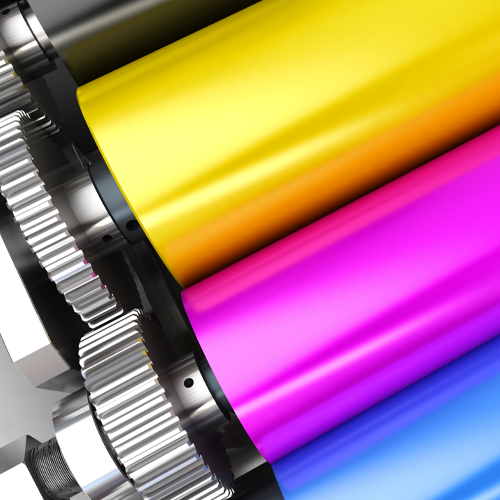Metallic Inks
Printing with Metallic Inks
Metallic inks are formulated with tiny metallic flakes which “leaf” together on the printed surface as the ink dries. This leafing of the metallic flakes creates a brilliant luster. Aluminum flakes are used for silver and brass flakes are used for gold.
The gold shades are varied from reddish gold to yellowish gold by varying the metallic composition of the flake and using different tinted varnishes. Pantone Matching System (PMS) 871 to 877 basic metallic inks are pre-mixed and are formulated to run straight out of the can and will not tarnish in the can, even after a year on the shelf.
Pantone metallic colors other than PMS 871 to 877, involve mixing a basic metallic with a standard non-metallic Pantone base. These mixed metallic inks are very unstable in the can and should be run as soon as possible after being mixed. Metallic inks are softer than regular ink. They are formulated this way so the metallic flakes can “leaf out” on the printing surface to achieve the maximum brilliance.

Paper
Coated paper with good ink hold-out produces the highest metallic luster. Smooth, uncoated papers give good results with a slightly lower luster. Papers with rough surfaces prevent the tiny metallic ink pigment flakes from “leafing” together and much of the metallic effect is lost.
Fountain solution
Metallic inks do not require any special fountain solution. Avoid electrostatic fountain solutions and those containing high amounts of glycerin or glycol. These non-evaporating wetting agents can slow down drying.
Ink film thickness
Metallic inks are so opaque it is easy to run too much ink, which can overpower the dampening system. Even experienced press operators can apply too much ink inadvertently in an effort to produce the maximum metallic effect. The best way to prevent this is to start with a light image and increase the ink gradually.
Most Often Asked Questions About Metallic Inks
Q: My metallic inks dry fast, but sometimes when I rub my finger on the printed copy, the metallic ink rubs off. Why does this happen?
A: Some stocks, particularly cast-coated and clay-coated enamels may sometimes cause the ink varnishes to be drained into the paper coating, leaving the metal pigments on the surface of the stock without enough binder to anchor it firmly to the paper. This condition is called “chalking.” Aqueous coating should always be applied when printing with metallic inks. It will seal the sheet and prevent the metallic colors from chalking.
Q: Do you have Laser-Safe metallic inks?
A: We do not recommend any true metallic inks for use on stationery which is going to be run through a laser printer or high speed copier. The metallic flakes used to make a metallic ink get their brilliance from the “leafing” of the metallic flakes on the printed sheet. The heat and pressure of a laser printer or high speed copier can cause the metallic flakes to peel off the sheet, stick to the fuser roller or drum and be costly to repair. If you plan on running a sheet printed with metallic inks through a laser printer or high speed copier, let your sales representative know, so he can suggest an imitation metallic ink specially formulated for this type of use. Although the luster will not be the same as a traditional metallic ink, it’s as close as you can get under the circumstances.
Wash-up
Metallic inks do not require special roller washes, however, the metallic flake in the metallic inks are often more difficult to remove than regular ink.
